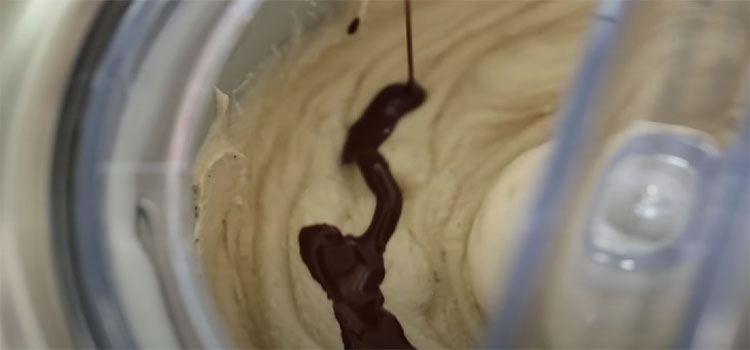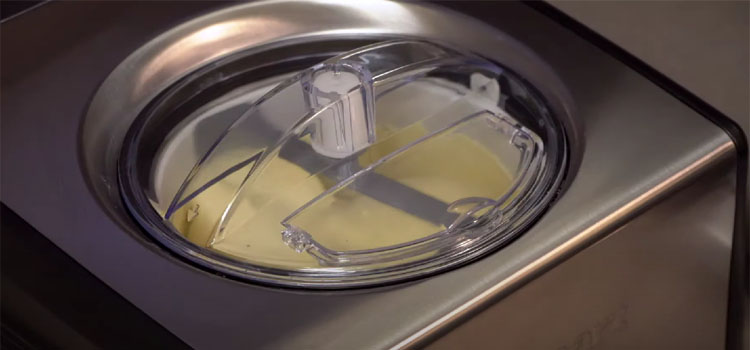Last Updated on September 15, 2024 by Shari Mason
Whipping up your own ice cream at home is like embarking on an exciting journey, often filled with anticipation and sudden moments of joy when the churn finally gives you that perfect, creamy texture.
When it comes to knowing when the ice cream is ready, a personal touch goes a long way. I remember the first time I made ice cream; I relied on the machine’s sound and texture cues.
But, really, how can you tell when ice cream is done churning? Let’s find out.
5 Ways To Tell If Ice Cream Is Done Churning
1. Texture Check


The texture is one of the most reliable indicators to ascertain whether your ice cream is done churning.
As the churning [1] process progresses, the mixture transforms from a liquid state to a more creamy and thick consistency reminiscent of soft-serve ice cream.
“Perhaps summer’s ephemeral nature inspires us to embrace the beach read. We tell ourselves that these twisted plots and wild characters are literary ice cream sundaes – extravagant treats that aren’t as calorie-laden when we’re wearing flip flops.”
– Sarah MacLean, American Writer
When you notice that the mixture has gained substantial volume, appears smooth, and holds its shape momentarily when you lift a spoonful, it’s a clear sign that your ice cream has reached its desired consistency and is ready to be transferred for the final freezing.
Read:
- How Long Does Homemade Ice Cream Last In Freezer?
- How To Keep Ice Cream From Melting In A Car?
- How To Make Dairy Queen Peanut Butter Sauce?
- Breyer’s Delights Vs. Halo Top
- Soft Serve Ice Cream Recipe For Machine?
2. Volume Increase
Another discernible sign that your ice cream is nearing completion during the churning process is the noticeable increase in volume.
As the ice cream maker works magic, the mixture aerates, incorporating tiny air bubbles into its creamy texture. This aeration process causes the mixture to expand within the churner.
When you observe that the mixture has nearly doubled in size or fills up a significant portion of the churner’s capacity, it strongly indicates that the churning phase is almost done, and your ice cream is ready for the next step.
Find out what do you call someone who makes ice cream.
3. Pull Away from the Sides


A clear visual cue to gauge the readiness of your churning ice cream is its behavior on the sides of the churner.
As the mixture thickens and reaches the desired consistency, it will begin to pull away or detach from the walls of the container.
This detachment indicates that the ice cream has formed a substantial body and is no longer as liquid as it was at the start.
4. Time
One of the most straightforward methods to determine if ice cream [2] has finished churning is by keeping an eye on the clock.
Most ice cream recipes will provide an approximate churning time, typically ranging from 20 to 30 minutes.
While variations can arise due to the specific machine, ingredients, or room temperature, adhering to the suggested churn time is a dependable guide.
However, it’s crucial not to rely solely on time, as other indicators should also be considered. But, as a rule of thumb, once you’ve reached the provided churning duration, it’s a good moment to check other signs to ascertain the ice cream’s readiness.
5. Taste Test


The taste test is the most enjoyable way to determine if your ice cream is done churning. As the mixture churns and evolves, periodically taking a small sample can give you insights into its development.
When the flavor is rich, and the consistency is creamy without being overly icy or grainy, it’s a sign that your treat is nearing perfection.
“In the dance of churn and cream, when the swirl holds its dream, that’s when ice cream takes its gleam.”
– Eat Pallet Restaurant & Food Advice
This method allows you to monitor the ice cream’s progress and ensures that the final product will be precise to your liking in terms of flavor and creaminess.
Remember, the best judge of a delightful dessert is your palate.
FAQs
u003cstrongu003eHow long does ice cream need to freeze after churning?u003c/strongu003e
After churning, ice cream should be transferred to an airtight container and frozen for at least 2 to 4 hours to firm up. u003cbru003eu003cbru003eHowever, allowing it to freeze overnight or for at least 6-8 hours is recommended for the best consistency and flavor. u003cbru003eu003cbru003eThis ensures the ice cream reaches a solid, scoopable state and the flavors meld and mature optimally.
u003cstrongu003eCan you churn ice cream for too long?u003c/strongu003e
Yes, you can churn ice cream for too long. Over-churning ice cream can result in a grainy or buttery texture. u003cbru003eu003cbru003eAs the churning process continues, the fat in the mixture can begin to clump together, forming larger ice crystals and potentially causing the mixture to separate. u003cbru003eu003cbru003eChurning incorporates air and breaks down ice crystals to achieve a smooth texture. u003cbru003eu003cbru003eHowever, once the optimum texture is reached, continuing to churn can adversely affect the final product’s consistency and flavor.
In Conclusion
Knowing when the mixture has reached its ideal consistency is crucial for the perfect scoop in the art of ice cream making.
Observing the texture, noting the volume increase, witnessing the mixture pulling away from the sides, keeping track of the churn time, and trusting your taste buds can ensure your ice cream is churned to perfection.
Remember, the goal is a smooth, creamy consistency that’s neither soft nor hard. Mastering these signs will elevate your homemade ice cream endeavors, bringing delight to every bite.
References:
- https://www.britannica.com/technology/churn
- https://www.foodandwine.com/desserts/frozen-desserts/ice-cream/ice-cream
- Can You Put an AC Unit in the Kitchen? - September 27, 2024
- What Cheese Does Olive Garden Use? Discover Their Signature - September 27, 2024
- How to Cancel a Pizza Hut Order? Quick & Easy Guide - September 24, 2024


